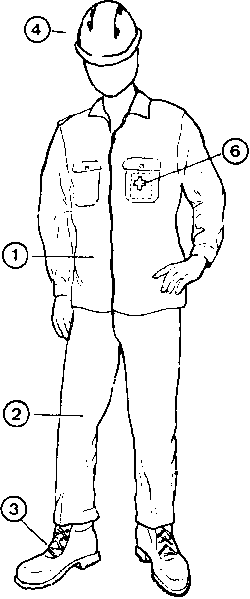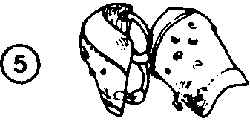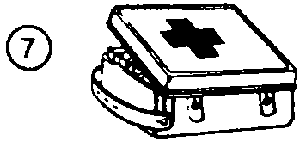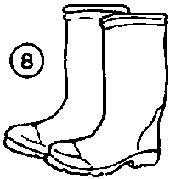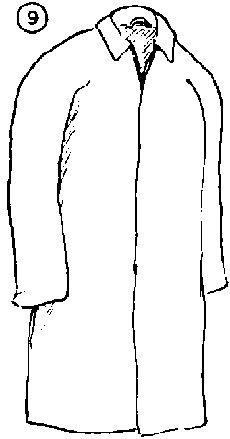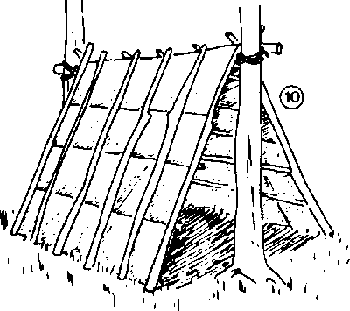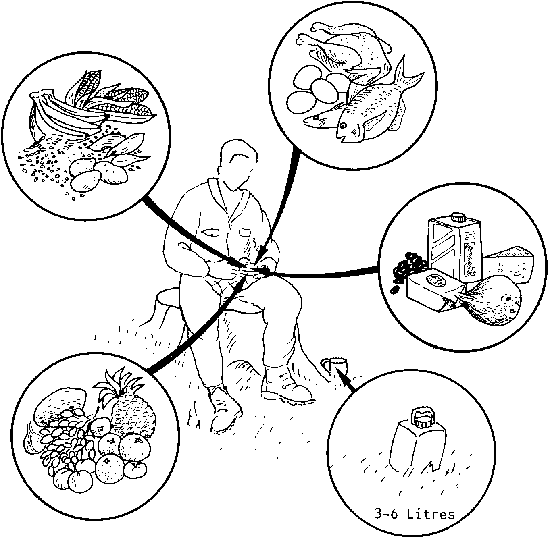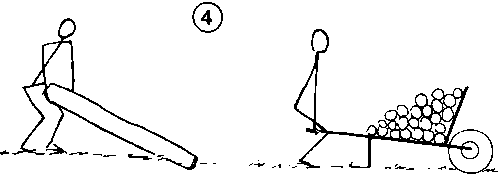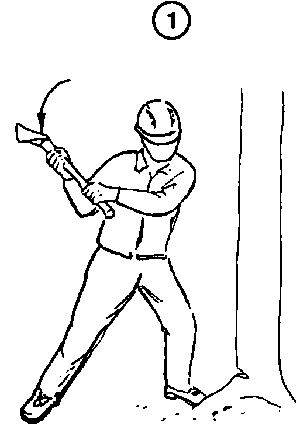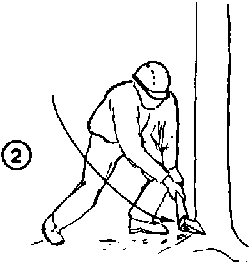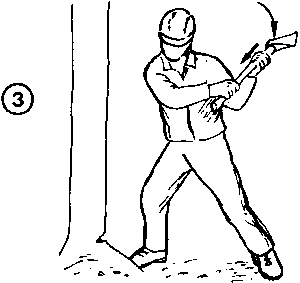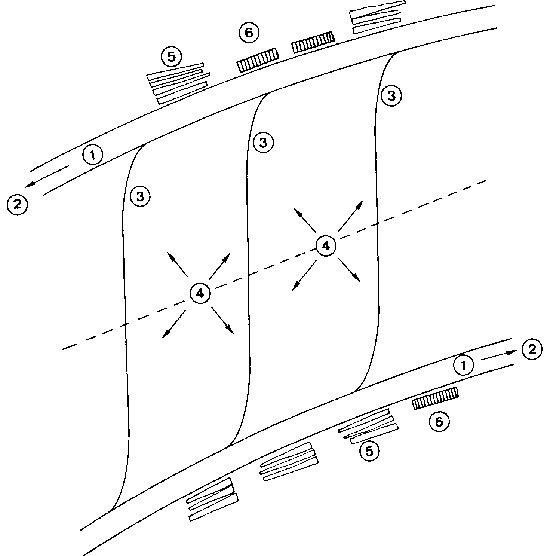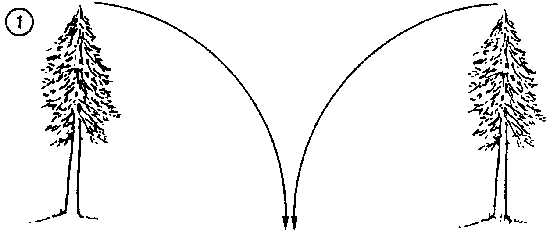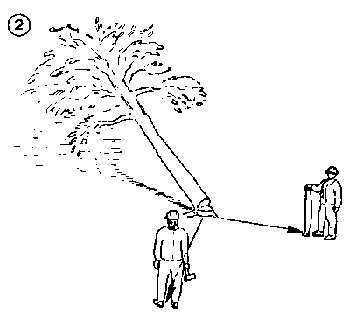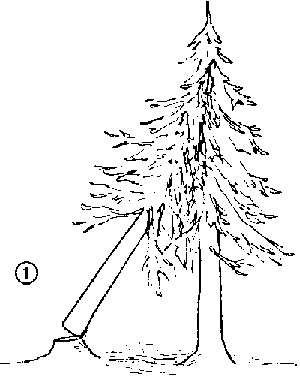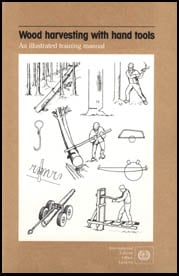
The Worker[edit | edit source]
CLOTHING, PERSONAL PROTECTIVE EQUIPMENT, FIRST-AID EQUIPMENT[edit | edit source]
Workers should wear:
(1) Long-sleeved shirt or jacket, preferably in a warning colour, fitting neither too loosely nor too tightly.
(3) Boots with non-slip soles.
In felling operations, the worker must wear:
(4) Safety helmet with ventilation holes.
During the felling of large-sized trees, it may be advisable to use:
(5) Knee protectors.
The following first-aid equipment must be available:
(6) A pocket first-aid kit containing roller bandages and standard dressing for open wounds, carried by the worker.
(7) A full first-aid kit for treating serious accidents, to be kept at the work site for a group of workers.
During rainy periods, workers should have:
(8) Rubber boots.
(9) Raincoats.
Simple shelters should be available for use during breaks as a protection against rain or sun (10).
Figure
Figure
Figure
Figure
Figure
Figure
FOOD, NUTRITION AND REST[edit | edit source]
Wood harvesting is heavy work and over a period of time is tiring. The worker must therefore be in a good state of health and be well fed.
He should have a meal before starting work and eat during breaks.
Under severe climatic conditions (very hot weather or humid, tropical climate), not more than six hours of productive work can be expected. During a six-hour working day, two meal breaks of at least 30 minutes each should be taken (after the first two hours of work and again two hours later).
Food should be sufficiently rich in starches (rice, maize, wheat, millet, bananas, cassava); in proteins (beans, eggs, meat, fish); in fats (olive oil, coconut oil, cheese, butter); and in vitamins (fruit, vegetables).
During hard work and in hot weather, the body can lose 3 to 6 litres of liquid per day. This must be replaced. Workers should carry a container with boiled water, tea or other beverages and drink not only when thirsty but also at regular intervals during the day. Care must be taken to replace the salt lost through sweating.
Figure
WORKING POSTURES AND MOVEMENTS[edit | edit source]
Heavy physical work can be made easier by proper working postures and working movements.
Sawing can become very tiring and quite inefficient if the saw is pulled by the arms towards the body, if the body remains stiff and upright and consequently only short strokes can be made.
To make the job less tiring and more efficient, the saw should work along its full length and the load should be carried not only by the arm muscles but by the whole body swinging backwards and forwards and supporting the movement of the saw.
Efficient working techniques in the use of bow saws (1) and crosscut saws (2) are indicated in the illustration, showing the change in working position. The same principles apply to other jobs, such as debarking (3).
Manual wood harvesting often involves heavy lifting and carrying of loads. In such work, the back should be kept straight to avoid excessive strain and the strong muscles of the legs should be used for lifting (4).
Figure
Figure
Figure
Figure
In axe work, the whole body moves and supports the stroke by changing the weight from the leg away from the cut to the leg near the cut while the upper hand slides down the handle. If the worker masters the left-hand grip (1), (2) and the right-hand grip (3), work is safer and less strenuous.
Figure
Figure
Figure
WORK PLANNING AND ORGANISATION[edit | edit source]
Wood harvesting must be well planned and organised in order to make the best use of the raw material while keeping labour input and production cost low and minimising damage to the environment.
A variety of different harvesting systems can be applied depending on the wood species, size and assortment (fuelwood, poles or logs), type of forest (man-made or natural), type of cut (thinning or clear cut), kind of regeneration (artificial, coppice, natural), terrain (flat, steep, swampy), accessibility (roads, waterways) and means of transport (manual, animal, motorised).
In all these cases, good planning and organisation of work depends on:
- the assessment of the volume to be harvested;
- the determination of the assortments to be produced;
- the determination of wood storing places, skidding lines and felling direction;
- clearly-instructed and skilled supervisors and workers;
- availability of the necessary hand tools and maintenance and other equipment;
- clear separation of working areas for individual work teams and different operations (felling and transport).
The illustration shows an example of a harvesting map indicating the forest road network (1), the transport direction (2), the skidding lines (3), the felling direction (4) and the storage places for logs (5) and short wood (6).
Figure
ACCIDENT PREVENTION[edit | edit source]
Wood harvesting is extremely dangerous. Many workers are killed or severely injured in tree felling and transport. Cutting tools may lead to serious open wounds. Many accidents occur when workers slip, stumble and fall in difficult terrain or on slippery surfaces.
Adequate accident prevention is therefore a basic requirement of any type of wood harvesting.
Workers need to be healthy and in good physical condition. They must be well trained for their jobs. They must strictly observe a definite set of safety rules.
The most important safety rules are the following:
- In tree felling, workers must use safety helmets, wear good shoes with non-slip soles and carry first aid equipment.
- Axes, saws and helping tools should be available in sufficient number and be adequate as regards type and maintenance.
- The felling team must keep a minimum distance of two tree lengths from other workers (1). This distance may be increased to four tree lengths when visibility in the forest is poor. A warning should be given before a tree is about to fall.
- Greatest care is required in controlling trees during felling by an adequate undercut and back cut, leaving a sufficiently strong hinge.
- When the tree falls, the worker must retreat to a safe position and watch out for falling branches (2).
Figure
Figure
- Particular care is needed to bring lodged trees down safely (1).
- No tree felling should be done in stormy weather.
- During debranching, debarking and cross-cutting, workers must watch out that they are not caught by falling, sliding or turning trees or parts of trees, especially on slopes.
- When axes, debarking spades or splitting hammers are being used, other people must keep clear of the working range.
- Accidents are more frequent towards the end of the day when workers are tired. During this period, harvesting should preferably concentrate on the less dangerous jobs.
Figure
The working techniques described in this manual are specifically designed with a view to reducing hazards.
